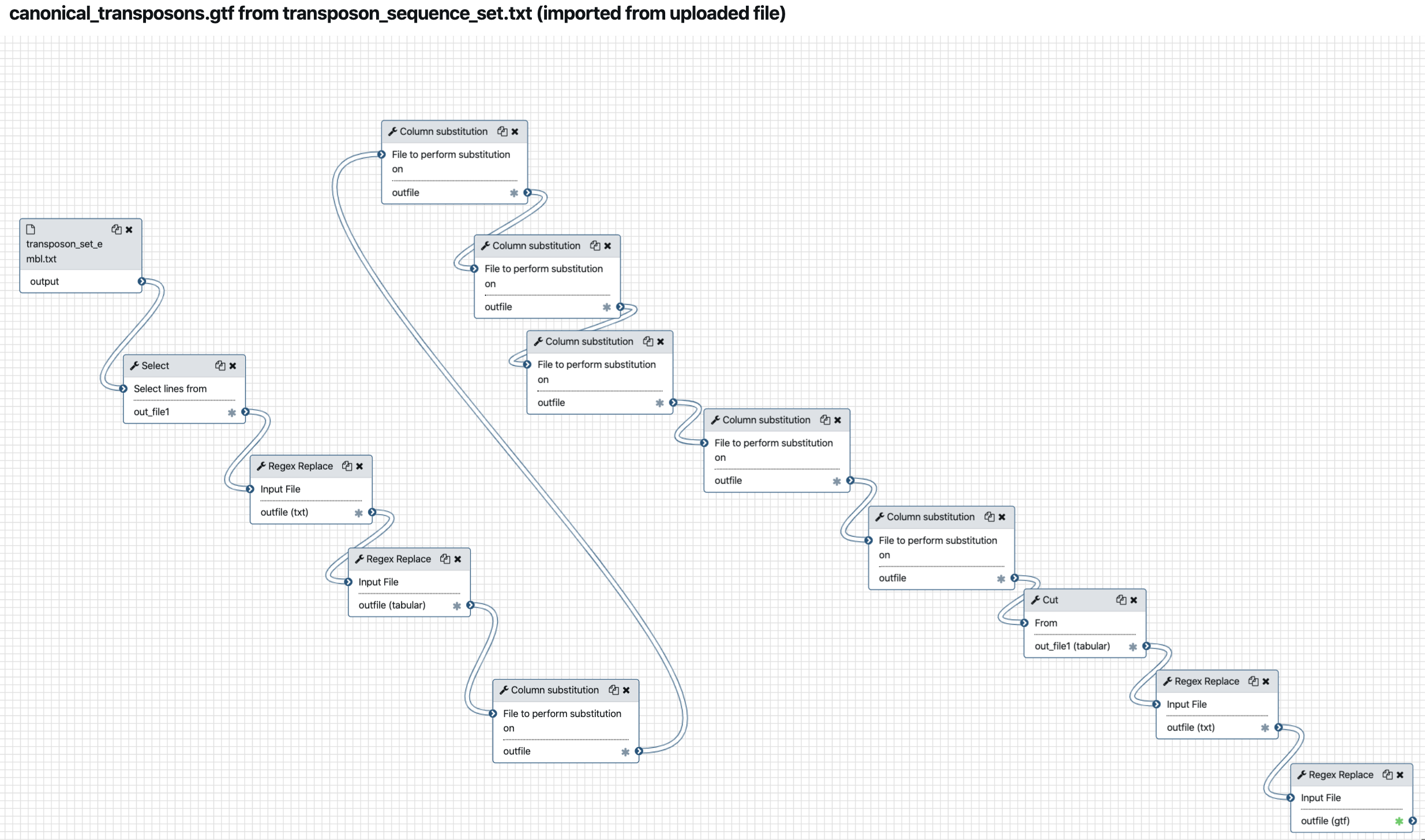Running a workflow in Galaxy¶
In this use case, we are going to
- Upload 3 workflow description files in the Galaxy server instance
- Visualise these workflows and see that tools to execute the workflows are missing
- since you are administrating the instance, install the missing tools
- Eventually run the workflows on input data obtained from a remote public repository.
1. Upload workflow description file (.ga)¶
- Ensure you are connected to your Galaxy server as an admin (the email you have entered in the galaxy.yml configuration file and the password to you've entered for this login when you registered for the first time)
- Click the workflow menu
- Click the "Upload or import workflow" button at the top right
-
In the
Galaxy workflow URL:field, paste the url of the workflow file:Note that this file is in the Run-Galaxy repository where a part of the material for this training is hostedhttps://raw.githubusercontent.com/ARTbio/Run-Galaxy/master/workflows/Galaxy-Workflow-canonical_transposons.gtf_from_transposon_sequence_set.txt.ga -
Click on the
Importbutton -
repeat the same operation with the second workflow
-
repeat the same operation with the third workflow
Note
Alternatively, you could upload the workflow files from you computer instead of uploading them by URL
- the
Workflowmenu is now a list of 3 workflows that should look like :

- Click the workflow
canonical_transposons.gtf from transposon_sequence_set.txt (imported from uploaded file)and theEditoption - Observe the warning window that should look like:
Issues loading this workflow
Please review the following issues, possibly resulting from tool upgrades or changes.
- Step 3: toolshed.g2.bx.psu.edu/repos/galaxyp/regex_find_replace/regex1/1.0.1
- Tool is not installed
- Step 4: toolshed.g2.bx.psu.edu/repos/galaxyp/regex_find_replace/regexColumn1/1.0.1
- Tool is not installed
- Step 5: toolshed.g2.bx.psu.edu/repos/galaxyp/regex_find_replace/regexColumn1/1.0.1
- Tool is not installed
- Step 6: toolshed.g2.bx.psu.edu/repos/galaxyp/regex_find_replace/regexColumn1/1.0.1
- Tool is not installed
- Step 7: toolshed.g2.bx.psu.edu/repos/galaxyp/regex_find_replace/regexColumn1/1.0.1
- Tool is not installed
- Step 9: toolshed.g2.bx.psu.edu/repos/galaxyp/regex_find_replace/regex1/1.0.1
- Tool is not installed
When you read the warnings, you will see that the workflow was indeed successfully imported. However, some tools are missing, namely:
toolshed.g2.bx.psu.edu/repos/galaxyp/regex_find_replace/regex1/1.0.1
toolshed.g2.bx.psu.edu/repos/galaxyp/regex_find_replace/regexColumn1/1.0.1
Click on the Continue button. You should now see missing tools in red and missing links
between various workflow steps. Note that some tools are indeed present because they are
installed by default in the provided Galaxy framework.
broken workflow

- We are going to fix this. Click on the
Continuebutton and then the upper "wheel" icon and selectClose, we will come back to the workflow editor when the missing tools are installed in the server.
2. Installing (missing) tools¶
The missing tools are reported in the tools.yml file in yaml format in the Run-Galaxy repository, as well as just bellow.
Details of missing tools
Thus, we have to install the following missing tool in our Galaxy instance:
tools:
- Click on the
Admintop menu - In the left bar click on
Manage tools
Check that there is actually no installed tools !
- Now, click the
Install new toolsmenu (again in the left bar) - Press the
Galaxy Main Tool Shedbutton - In the search field, copy and paste and press the Enter key.
- Two tools will show up, one owned by
jjohnsonand the other owned bygalaxyp. We want to install the latter one, click on it and selectinstallbutton of the lattest revision (2, version 1.0.1) - In the
Target Section:menu, selectText Manipulation. Thus, the tool will appears in the sectionText Manipulationof the Galaxy tools. - Click
OK - After a few seconds, you will notice the
Cloning...then soonInstalling dependenciesdisplayed by the install button. - And rapidly enough, the
Installbutton should turn to a redUninstallbutton. - You can now check the
Installed onlycircle at the top, and look at the newly installed toolregex_find_replacein the list.
3. Check that the imported workflows now display correctly¶
If you click the workflow top menu, you should now be able to edit the imported workflows,
and see that everything is displaying correctly. For the workflow
canonical_transposons.gtf from transposon_sequence_set.txt :

We can go through the various steps of the workflows and figure out what they are doing.
This first workflow performs a suite of find-and-replace text manipulations, starting
from input data that has been tagged transposon_set_embl.txt and producing a new text
dataset that is renamed canonical_transposons.gtf.
The second workflow uses the same input data file transposon_set_embl.txt to generate
a fasta file of canonical_transposon sequences
The third workflow is a workflow of the two previous workflows !
We will come back to all these steps after the workflows execution. However, we need to retrieve the input data set before running the workflows on these data.
4. Retrieve the transposon_set_embl.txt dataset¶
- Create a new history and name it
transposon_set_embl.txt manipulation -
import the dataset using the
Paste/Fetch datamode of the upload manager (the small bottom-top arrow icon at the top left of the Galaxy interface). Copy the URLin the open field and click thehttps://github.com/bergmanlab/transposons/raw/2018c2e848cec2aefc4a87187d5ed5927d04c9a4/current/transposon_sequence_set.embl.txtStartbutton. -
have a close look at the file
5. Run the workflow¶
- Click on the workflow menu
- Click on the first workflow and select the Run option
- Leave the
Send results to a new historymenu to theNooption for the moment. - Just Click the
Run workflowbutton to run the workflow, and look at datasets in the history turning from grey to yellow to green. Note: often you don't see the dataset in the "yellow" state (running). You just need to refresh the history with the 2-curved-arrows icon of the local history menu. - repeat the same operation (from the input history) for the second workflow
Extract canonical transposons fasta (imported from uploaded file)
Discussion on workflows and on workflow of workflows¶
6. Stop and destroy your bare-galaxy instance¶
Since we are now at the end of the first use case, we can destroy the VM instance.
- Go to you Google Cloud Platform management web page.
- Select your bare-galaxy VM
- roll-down the top menu with the 3 vertical dots, and select
Supprimer
